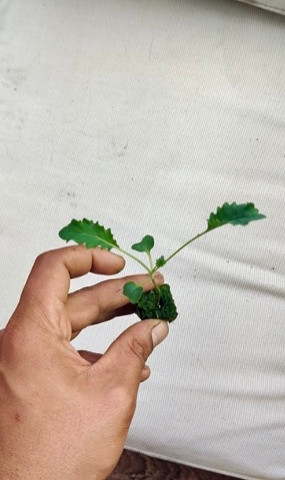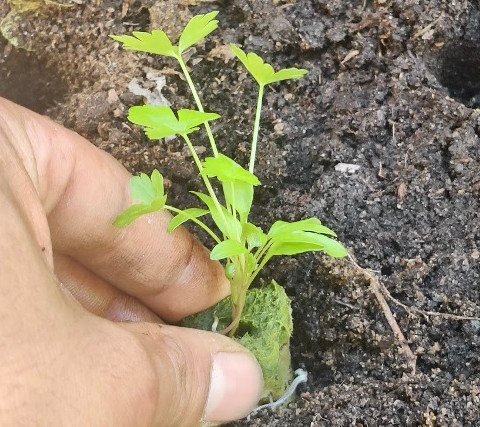Growing at Home: Part 3 Transplanting Your Seedlings
- Dish

- Apr 8, 2020
- 4 min read

Over the coming weeks and months Dish, our Head Farmer, is going to share his experiences of moving our urban farm to his home and provide tips and guidance on how you can also grow at home to help you learn, clear your mind, and grow your own fresh produce.
In this blog we’ll be following the journey of young seedlings growing at our home farm. Dish will explain how to transplant the seedlings into both hydroponic and conventional growing environments. This will allow us to compare the advantages and disadvantages of various growing systems as the plants mature.
What is transplanting?
Our seedlings are now ready to be transplanted or ‘planted out’. This is the process of moving a seedling to a location where it will mature fully. In our hydroponic system this will mean moving the seedlings from their densely packed trays to our vertical towers, where they’ll be able to spread out. In your vegetable garden, this will mean planting your seedlings into the ground or into pots/ containers.

How do I know when my seedlings are ready to be transplanted?
Different crops grow at different speeds. For example, our Cavolo Nero Kale plants took a week to germinate in the dark and then spent three weeks in our hydroponic Flood and Drain system receiving light and nutrients. In comparison, our Flat Parsley plants have grown much more slowly: they’ve taken three weeks to germinate and have now spent four weeks on the hydroponic system.
Here a couple of key indications that your seedling is ready for transplanting:
The plant has grown its second and/or third set of leaves. Seedlings are too young to transplant when they have only grown their first leaves (cotyledon leaves). They must reach the ‘true leaf’ stage, where at least the second set of leaves have grown out.
If the root system is extensive. When we see that the roots are reaching out of the bottom of the trays they are growing in, they are ready.
You also need to be aware that seedlings can suffer from transplant shock, this is often caused by harm to the roots such as being damaged or drying out. The most effective way to prevent this is by allowing the root system to grow large enough before you transplant the seedling.
Transplant shock can also be caused by moving the plant into an environment that differs too greatly in temperature to where it was propagated. Tender plants grown outdoors can be ‘hardened off’ by placing them in a shaded area, sheltered from strong wind for two to three weeks, a cold frame is great for this. Also make sure you are planting out the crop at the right time of the year so there is little to no risk of frost damage.
Comparing Hydroponic and Conventional Growing Environments
While we’re at home we’re going to use this opportunity to compare two different growing environments, my outdoor vegetable bed and our indoor vertical, hydroponic system.
To do so, I will transplant our Kale and Parsley seedlings into these two environments. Five of each plant will go into our vertical hydroponic system (Group A) and five of each will go into my outdoor vegetable bed (Group B).
These are the key differences between the placements that could affect overall growth:
Group A will get a 24/7 supply of pH balanced nutrient solution to their roots in the hydroponic system. Group B will grow in a healthy soil, rich in organic matter.
Group A will be grown in a conservatory, which will generally have higher temperature, humidity and CO₂ than the outdoor vegetable bed. This will likely increase growth rates.
Group B will be subject to strong winds, which could cause damage to plants.
Group B has a higher risk of damage by pests such as slugs and snails.
Group B requires manual watering, especially when rain is scarce.
How to transplant your seedlings
Transplanting into our vertical system is very easy. I simply slotted each plant into the holes protruding out of the tower. This system works by using a dripper to feed the top of the towers, the nutrient solution cascades down and feeds all of the plant roots. The roots have ample space to grow and will eventually fill most of the space in the tower.
Transplanting into the vegetable bed is also straightforward. I formed holes which were roughly 20cm apart and planted into these holes. Covering the top of the plugs and filling any gaps with soil. I immediately watered the plants in the raised bed to get things started. To make sure this is a fair comparison, I will manually water Group B daily in case they dry out. These plants can also be planted into plant pots or other containers.
Top Tip: Some plants like Parsley, Dill and Coriander can grow really well in clusters with multiple seedlings in one plug. However plants that will become quite sizeable and thick stalked such as Kale, Chard and Basil should be thinned out so only one seedling is growing in a plug.
We will be posting updates on these plants as we monitor their progress. Follow their journey on Instagram and in future blogs! You can sign up to receive our newsletter here to keep up to date with us, we also send out recipe ideas and a round-up of relevant news. If you’ve got any questions about growing your own, get in touch with us at hello@squaremilefarms.com or message us on social media (links below).
Dish is Square Mile Farms’ Head Farmer. He’s spent the last year experimenting with growing 40+ types of vegetables, herbs and microgreens at our Paddington rooftop farm and in our office farm installations. Using his knowledge of building and maintaining indoor hydroponic systems he is on a mission to help London workers reconnect with their food by helping them grow it themselves!
Square Mile Farms bring vertical, urban farming to city dwellers in their homes and in the workplace. We aim to bring people closer to food production and help to create a culture of healthy, sustainable living. Find out more about our offering and get in touch here with any queries. Sign up to our newsletter for tips on a healthy lifestyle and a round-up of relevant news. You can also follow us on social media to stay up to date with our journey, find us on Instagram, Twitter and Facebook. Why not join our online Urban Growing Community for advice on growing at home and much more!
.jpg)























Comments